
 |
Tea Clipper |
 |
| from TeaAntiques.com | ||
| Edition Sixty Eight |
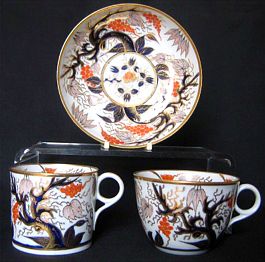 A
delightful set of six New Hall trio comprising a coffee can, teacup and saucer,
each beautifully decorated with pattern number 446, this in an 'Imari' palette
depicting a fruiting grape vine. These trio, one of which is shown here, would
have been made at the New Hall works c1810. A trio was the way in which many tea
sets of this period were supplied, a teacup and coffee can sharing one saucer.
A
delightful set of six New Hall trio comprising a coffee can, teacup and saucer,
each beautifully decorated with pattern number 446, this in an 'Imari' palette
depicting a fruiting grape vine. These trio, one of which is shown here, would
have been made at the New Hall works c1810. A trio was the way in which many tea
sets of this period were supplied, a teacup and coffee can sharing one saucer.
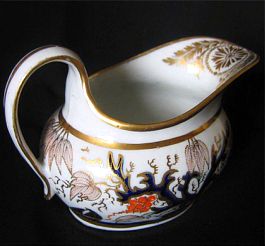 There
are six of these trios on my web site and are available as individual trios.
There
are six of these trios on my web site and are available as individual trios.
The trio do not carry the pattern number, this is only to be found on the milk jug of this part set, which is also available on the web site.
More details of this item and other tea related antiques can be found by visiting my web site at www.TeaAntiques.com.
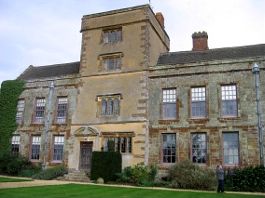 What
more tranquil house can there be than Canons Ashby, so quintessentially English.
This beautiful 16th century house is not too grand or imposing, but appears as a
quiet and restful home that looks to still be living in the past.
What
more tranquil house can there be than Canons Ashby, so quintessentially English.
This beautiful 16th century house is not too grand or imposing, but appears as a
quiet and restful home that looks to still be living in the past.
Unlike many country houses, Canons Ashby is set on a country road side, rather than being set away in its own secluded grounds. Despite this, to the South and east of the house are some gardens with beautiful views over the rolling countryside.
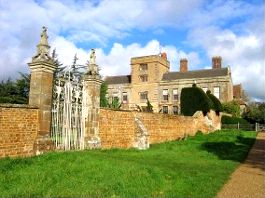 From
the car park, the walk takes you along side the garden wall where there are tantalising
glimpses of the house, with its central church like central block rising up above
the wall - this the staircase tower. This early house has had a few Eighteenth century
alterations, particularly to windows on the South elevation to take advantage of
the bigger Georgian sash windows allowing for extra light in the rooms. Although
it has had such alterations, inside there still remains a Jacobean atmosphere and
some fine plasterwork and wall paintings from this period.
From
the car park, the walk takes you along side the garden wall where there are tantalising
glimpses of the house, with its central church like central block rising up above
the wall - this the staircase tower. This early house has had a few Eighteenth century
alterations, particularly to windows on the South elevation to take advantage of
the bigger Georgian sash windows allowing for extra light in the rooms. Although
it has had such alterations, inside there still remains a Jacobean atmosphere and
some fine plasterwork and wall paintings from this period.
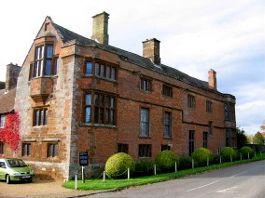 The
North elevation of the house, which abuts the little country road appears more traditional
16th century, here with its mellow red brick and stone dressings. This Jacobean
appearance extends to the West elevation. This is viewed from an enclosed garden,
which has topiary clipped yew trees which form an avenue to frame the view of the
house from the elegant stone pillared gates at the end of the garden. A large stone
statue of a shepherd boy playing his music pipes graces the avenue, looking towards
the central door of the house. The house from this view has a symmetrical facade,
with a gabled wing on each side. This elevation of the house is also built in red
brick but has been later rendered over to hide later alterations. The windows here
are stone mullioned rather than the later Georgian alterations. An elegant white
clock and bell tower surmounts the tiled roof.
The
North elevation of the house, which abuts the little country road appears more traditional
16th century, here with its mellow red brick and stone dressings. This Jacobean
appearance extends to the West elevation. This is viewed from an enclosed garden,
which has topiary clipped yew trees which form an avenue to frame the view of the
house from the elegant stone pillared gates at the end of the garden. A large stone
statue of a shepherd boy playing his music pipes graces the avenue, looking towards
the central door of the house. The house from this view has a symmetrical facade,
with a gabled wing on each side. This elevation of the house is also built in red
brick but has been later rendered over to hide later alterations. The windows here
are stone mullioned rather than the later Georgian alterations. An elegant white
clock and bell tower surmounts the tiled roof.
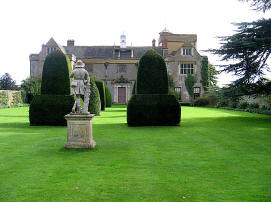
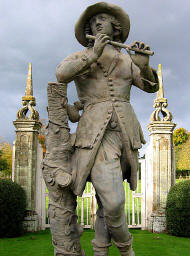
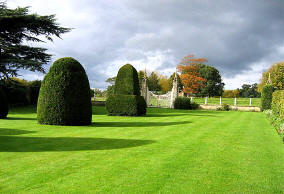
From the South side of this beautiful house, one can walk down past topiary yews and through an orchard of apple and pear trees to gates bounding the garden at the bottom of the walk. From this point turning round, affords a view back up to the house set upon on high ground. To the right on the other side of the garden wall there is a view of the village church tower rising up, square in section with four pinnacles on each corner.
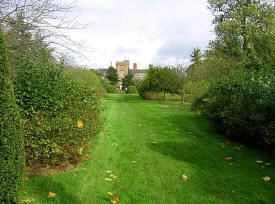
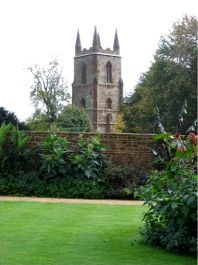
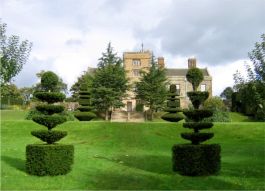
The house is entered through a tiny passageway, past the Old Brew-House and into an open courtyard on the East side of the house. This quaint courtyard area has an uneven pebbled surface. The house walls around the courtyard have stone mullion windows, these with diamond and square leaded lights. A set of stone steps lead up to the old oak door and into the Great Hall beyond.
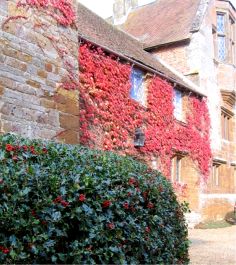
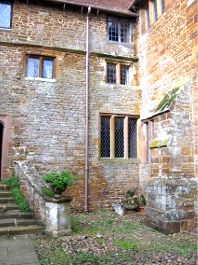
Visitors are ushered first down a little passage to the right of the Great Hall and into the old kitchen. This really is like stepping back in time. This large kitchen, with its flag stone floor was built by John Dryden for his Elizabethan House and has remained the kitchen ever since! The flagstones are worn by the movement of generations of servants going about their daily chores. A huge Victorian black cast iron range sits in the older stone lined fireplace - a modern convenience of the Victorian era. There is the usual array of copper pans, water urns and kettles dotted around the kitchen together with many other old kitchen implements. Extending underground from the kitchen are the wine cellars, now empty.
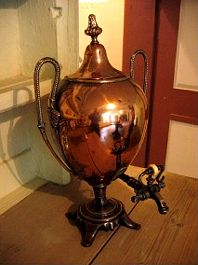 From
the kitchen, you make your way up some stairs into the Winter Parlour. A dark wood
panelled room, it was created in the 1580's as a more private dining room for the
family of the house, who until then, would have eaten with the rest of the household
in the great Chamber. Later on, after 1710, it became the upper servants Eating
Hall. There are some interesting family crests painted on some of the panels of
the wall, their colours still quite clear and vibrant. These may have been the crests
of people the family knew and who had visited them at Canons Ashby. However, latest
research has shown that a Masonic symbol painted in one wall panel, may indicate
that this room was in fact used as a Mason's Lodge. To the right of a great open
stone fireplace is a built in niche with in which stands a Victorian copper hot
water urn for tea. The one illustrated is a similar copper tea urn in Peckover house.
From
the kitchen, you make your way up some stairs into the Winter Parlour. A dark wood
panelled room, it was created in the 1580's as a more private dining room for the
family of the house, who until then, would have eaten with the rest of the household
in the great Chamber. Later on, after 1710, it became the upper servants Eating
Hall. There are some interesting family crests painted on some of the panels of
the wall, their colours still quite clear and vibrant. These may have been the crests
of people the family knew and who had visited them at Canons Ashby. However, latest
research has shown that a Masonic symbol painted in one wall panel, may indicate
that this room was in fact used as a Mason's Lodge. To the right of a great open
stone fireplace is a built in niche with in which stands a Victorian copper hot
water urn for tea. The one illustrated is a similar copper tea urn in Peckover house.
Moving back into the great hall which was the centre of the Elizabethan house created by John Dryden. As with all Great Halls of this period, it was used for all sorts of functions and entertainment. Carrying on in this sort of tradition in the nineteenth century it was used as the Billiards Room, but now appears as a Great Hall once more. This rather stark Hall has some heraldic decoration together with some armour.
Leaving the Great Hall and passing into the Grand Staircase, you turn right into the Dining Room on the South front of the house - originally the 'right hand parlour'. As part of the later alterations to this room, the sash windows were introduced allowing more light into the room. It was made to feel warmer by introducing oak wood panelling around the walls in large rectangular panels. The panelling still gives the room a rather dark and sombre feel, lightened only by the flash of brilliant red rouched curtains. A fine set of Dryden family portraits adorn the walls, many looking very stern in their Elizabethan poses.
A large rectangular marble open fireplace has above it a beautiful walnut framed mirror, this in three horizontal mirrored sections, the top frame having a domed top in the centre section and a curvaceous frame line to the top of the flanking sections. This was made at the same time as the wall panelling was added and so the wall panel above the mirror reflects this unusual shape. In the centre of this room stands a rectangular dining table, with turned legs terminating in 'club' or 'pad' feet, c1750. There is a set of mahogany dining chairs with solid vase shaped back splats, cabriole legs with turned stretchers between them and solid wooden seats. These dating again from the mid eighteenth century. the illustrations below show similar chairs from my own collection and a pad foot of a table leg.
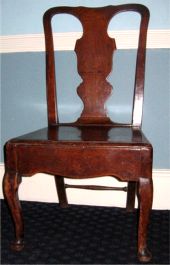
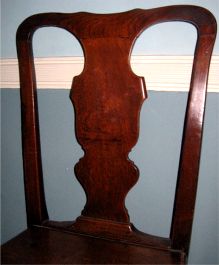
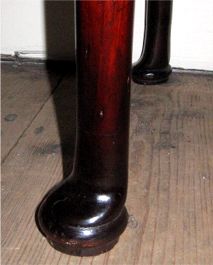
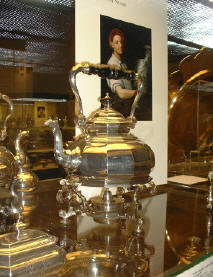 To
one end of the room stands a handsome eighteenth century sideboard of Adam style.
On this is one of the most interesting pieces I was to discover in the house - an
early eighteenth century silver tea kettle on stand. For the lover of tea antiques
this is a really fine early example of a tea kettle. What is nice, is that it is
engraved on the left face of the kettle with the family coat of arms of Edward and
Elizabeth Dryden. So, it still remains within the house for which it had been made,
which is lovely. It can be pictured, the family taking the then expensive tea with
their honoured guests in this very room. The kettle is of a rectangular octagonal
shape and has a swing handle of double 'C' scrolls leading to the ebony wooden handle.
The kettle sits upon a chunky silver stand with scroll feet and has at either end,
bracket handles that lift to lock the kettle to the base and to provide carrying
handles. As with these types of kettles there is a spirit burner within the stand
which when lit would keep the water in the kettle boiling for making the tea. Such
early tea kettles are rare to find, this very fine one was made by Thomas Sadler,
in London, 1712. The tea kettle illustrated here is a similar one in the British
Museum, London.
To
one end of the room stands a handsome eighteenth century sideboard of Adam style.
On this is one of the most interesting pieces I was to discover in the house - an
early eighteenth century silver tea kettle on stand. For the lover of tea antiques
this is a really fine early example of a tea kettle. What is nice, is that it is
engraved on the left face of the kettle with the family coat of arms of Edward and
Elizabeth Dryden. So, it still remains within the house for which it had been made,
which is lovely. It can be pictured, the family taking the then expensive tea with
their honoured guests in this very room. The kettle is of a rectangular octagonal
shape and has a swing handle of double 'C' scrolls leading to the ebony wooden handle.
The kettle sits upon a chunky silver stand with scroll feet and has at either end,
bracket handles that lift to lock the kettle to the base and to provide carrying
handles. As with these types of kettles there is a spirit burner within the stand
which when lit would keep the water in the kettle boiling for making the tea. Such
early tea kettles are rare to find, this very fine one was made by Thomas Sadler,
in London, 1712. The tea kettle illustrated here is a similar one in the British
Museum, London.
Moving back across the other side of the Grand Staircase is the Book Room. This room has been altered in the 1840-50 period to accommodate library shelves to store all the books collected by Sir Henry Dryden. These shelves give this room a Victorian feel rather than Elizabethan. In the centre of the room is placed a mahogany partners desk and was obviously created as a room for study and learning.
Beyond the Book Room, in my mind, a more interesting room - the Painted Parlour. This room so named because it has intriguing panelling painted with faux Corinthian pilasters and marbled cornice. This in the early eighteenth century was a withdrawing room. This interesting decorative painting was the work of the cousin of Edward Dryden, Elizabeth Creed and maybe assisted by her daughter. The painted effects give this otherwise small room a grand appearance. The only furniture in the room are an elegant set of high backed cane seat and back dining chairs made of Walnut. These early English chairs have a beautifully carved crest rail and front stretcher.
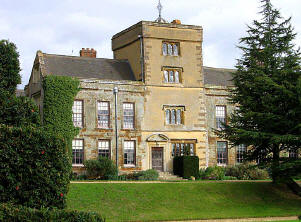 Retracing
your steps to the Grand Staircase within the square tower, you take the stairs up
to the first floor of the house. These impressive stairs in English Oak were added
to the house in the earl 17th century. There are heavy baluster turned stair rods
and carved rectangular newel posts with a carved ball and spike finial. These stairs
creak rather spookily as you make your way up them.
Retracing
your steps to the Grand Staircase within the square tower, you take the stairs up
to the first floor of the house. These impressive stairs in English Oak were added
to the house in the earl 17th century. There are heavy baluster turned stair rods
and carved rectangular newel posts with a carved ball and spike finial. These stairs
creak rather spookily as you make your way up them.
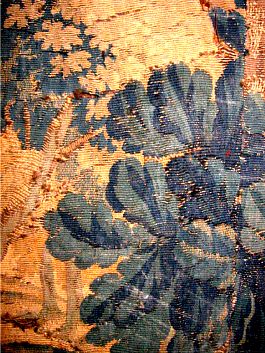 To
the right on the first floor is the Tapestry Room, which was altered to this in
the 1710 period, including moving the fireplace and adding the sash windows. Still
with its dark wood panelling, the room is made to feel lighter and warmer with the
hanging of large 17th century Flemish tapestries on the walls. The vibrant colours
and fine workmanship in the weaving of these tapestries is quite amazing. Tapestries
covers also adorn the walnut framed settee and side chairs in the room - an extremely
fine suite of early English furniture. A four poster bed with rich blue hangings
graces the room at one end.
To
the right on the first floor is the Tapestry Room, which was altered to this in
the 1710 period, including moving the fireplace and adding the sash windows. Still
with its dark wood panelling, the room is made to feel lighter and warmer with the
hanging of large 17th century Flemish tapestries on the walls. The vibrant colours
and fine workmanship in the weaving of these tapestries is quite amazing. Tapestries
covers also adorn the walnut framed settee and side chairs in the room - an extremely
fine suite of early English furniture. A four poster bed with rich blue hangings
graces the room at one end.
Making your way back across the landing of the Grand staircase you enter the Drawing Room. The first thing that strikes you is the marvellous barrelled ceiling with Jacobean plasterwork designs and a central pendant hanging down. This is the grandest room in the house and was in Elizabethan times the Great Chamber - used for all sorts of great entertaining. The ceiling is the creation of Sir John Dryden in 1632. This old fashioned design by the 1630's included motifs of thistles, pomegranates and scrolling foliage set in strapwork compartments. A massive fireplace and surround dominates the long wall opposite the windows. This impressive fireplace and overmantel was commissioned by Sir Erasmus Dryden in 1590. On the huge two columned fireplace stands an overmantel that has two panels, which are bounded by double marbled columns. Within the two panels is painted two family coats of arms.
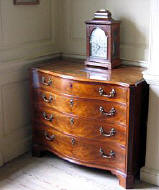 Once
again, crossing back to the Grand Staircase, northward leads to the Long Gallery.
It is usual to find such a long gallery in a house of this early period, this one
is unremarkable compared to many, but it does house some very good quality eighteenth
century furniture, including two very fine serpentine fronted chest of drawers.
These are not a pair, but have similar curvaceous front, canted corners with blind
fretwork decoration in the style of Chippendale. This type of chest of drawers is
similar to this one at Peckover House.
Once
again, crossing back to the Grand Staircase, northward leads to the Long Gallery.
It is usual to find such a long gallery in a house of this early period, this one
is unremarkable compared to many, but it does house some very good quality eighteenth
century furniture, including two very fine serpentine fronted chest of drawers.
These are not a pair, but have similar curvaceous front, canted corners with blind
fretwork decoration in the style of Chippendale. This type of chest of drawers is
similar to this one at Peckover House.
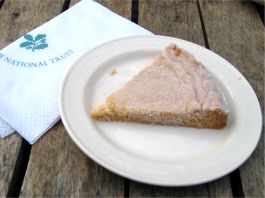
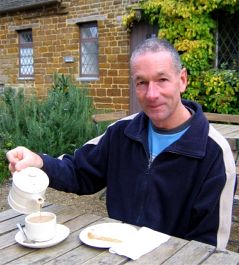
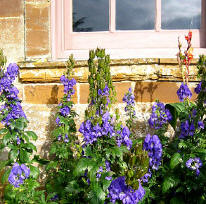
On completing a tour of the house, there is the Cottage Tea Rooms set off to one side of the house. It is pleasant on a fine day to sit out in this little cottage garden area and enjoy some tea and cake. On this occasion I sampled the shortbread, a very rich buttery biscuit which went well with a pot of Earl Grey tea. The perfect end to a very pleasant visit to this magically tranquil and historic house.
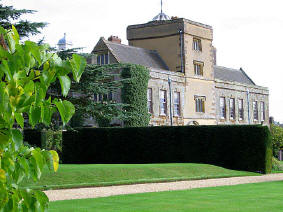
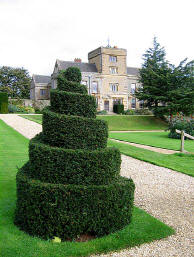
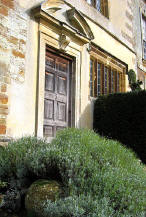
Canons Ashby House
Canons Ashby
Daventry
Northamptonshire
NN11 3SD
Click here for
Local Map
Map courtesy of www.streetmap.co.uk
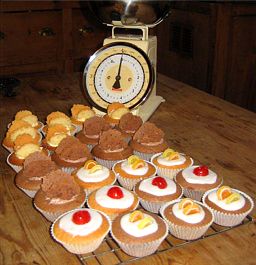 Where
have our little 'fancy' cakes gone? As a child, I remember that at afternoon teas,
we would often be served little fancy home-made cakes that brightened up the tea
table. Isn't it time that we all made a bit of effort to bring them back? I set
out and made my own little batch of small fancy cakes, that were easy to make and
quite delicious to eat.
Where
have our little 'fancy' cakes gone? As a child, I remember that at afternoon teas,
we would often be served little fancy home-made cakes that brightened up the tea
table. Isn't it time that we all made a bit of effort to bring them back? I set
out and made my own little batch of small fancy cakes, that were easy to make and
quite delicious to eat.
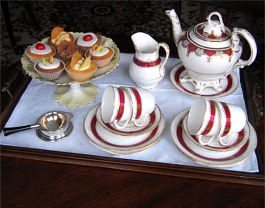 Next
time you think of making a large Sponge cake, why not bake the mixture in small
paper cups to allow you to have a variety of flavours and styles. For my batch of
cakes, once I had made the basic sponge cake mixture, I simply filled a dozen paper
cups with the plain mixture and then added cocoa powder to the other half of the
mixture which then filled a further dozen paper cups. These were then baked for
about 15-20 minute in the oven.
Next
time you think of making a large Sponge cake, why not bake the mixture in small
paper cups to allow you to have a variety of flavours and styles. For my batch of
cakes, once I had made the basic sponge cake mixture, I simply filled a dozen paper
cups with the plain mixture and then added cocoa powder to the other half of the
mixture which then filled a further dozen paper cups. These were then baked for
about 15-20 minute in the oven.
Having cooked the little cakes, it is then up to you how you decorate them - let your imagination go! I remember one of my favourites were 'butterfly' cakes. For these you just make up some butter cream made with just butter and icing sugar beaten together and then cut out a disc from the top of the cake and cut this in half to make the butterflies wings. Spoon a teaspoon of butter cream into the hollow made by cutting off the top f the cake and place the butterfly wings into the cream. For extra variety, I made half of them using basic butter cream and the rest with chocolate butter cream made by adding some cocoa powder into the butter cream that was left.
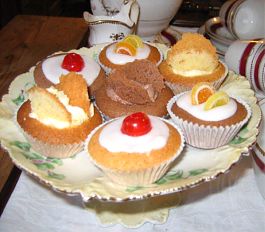 Further
simple ideas is to make some water icing, made from a little water that has icing
sugar beaten into it to make a soft icing. Adding a few drops of lemon juice will
help cut through the sweetness. This was used to ice the top of the remaining cakes.
Some I then topped with a half of a glacé cherry, or jelly sweets.
Further
simple ideas is to make some water icing, made from a little water that has icing
sugar beaten into it to make a soft icing. Adding a few drops of lemon juice will
help cut through the sweetness. This was used to ice the top of the remaining cakes.
Some I then topped with a half of a glacé cherry, or jelly sweets.
Arranged on a nice cake stand, these pretty cakes provide an attractive choice for your tea guests. I hope that you can do your part in promoting the making of these fancy little cakes bring a light hearted fun into afternoon tea.
To review past newsletters, just follow this link:
Past newsletters.
To subscribe to this free newsletter -
Click here